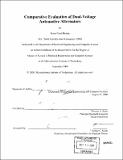| dc.contributor.advisor | Thomas A. Keim. | en_US |
| dc.contributor.author | Byrum, Jamie Carol, 1975- | en_US |
| dc.contributor.other | Massachusetts Institute of Technology. Dept. of Electrical Engineering and Computer Science. | en_US |
| dc.date.accessioned | 2005-08-23T15:31:03Z | |
| dc.date.available | 2005-08-23T15:31:03Z | |
| dc.date.copyright | 2000 | en_US |
| dc.date.issued | 2000 | en_US |
| dc.identifier.uri | http://hdl.handle.net/1721.1/8810 | |
| dc.description | Thesis (S.M.)--Massachusetts Institute of Technology, Dept. of Electrical Engineering and Computer Science, 2000. | en_US |
| dc.description | Includes bibliographical references (p. 181-184). | en_US |
| dc.description.abstract | The introduction of 42V / 14V dual-voltage automotive electrical systems in future automobiles necessitates dual-voltage power generation solutions capable of supplying power to both buses simultaneously. A dc / dc converter based system provides such a solution, but the cost, weight, and size of the converter hinder its attractiveness as a viable long term option. By contrast, dualvoltage alternators provide a potentially lighter, smaller, and less costly option for dual-voltage power generation, assuming they can be efficiently constructed with acceptable voltage ripple and control characteristics. This thesis examines two such options, the dual-rectifier alternator and dual-stator alternator, in terms of their electrical performance characteristics and the cost they add to today's automotive electrical system. Numerical simulation tools are used to evaluate one primary performance constraint, voltage ripple, and to size filtering solutions to attenuate ripple to acceptable margins. Implementation issues such as the application of new switched mode rectification techniques, dual-stator alternator controllability as a function of stator - stator turns ratio, dual-voltage power output capabilities, and the appropriateness of aluminum electrolytic capacitors for automotive applications are also discussed. These analyses are used to discuss the cost and weight characteristics of dual-voltage alternators meeting the minimum performance characteristics discussed. | en_US |
| dc.description.statementofresponsibility | by Jamie Carol Byrum. | en_US |
| dc.format.extent | 184 p. | en_US |
| dc.format.extent | 22341065 bytes | |
| dc.format.extent | 22340826 bytes | |
| dc.format.mimetype | application/pdf | |
| dc.format.mimetype | application/pdf | |
| dc.language.iso | eng | en_US |
| dc.publisher | Massachusetts Institute of Technology | en_US |
| dc.rights | M.I.T. theses are protected by copyright. They may be viewed from this source for any purpose, but reproduction or distribution in any format is prohibited without written permission. See provided URL for inquiries about permission. | en_US |
| dc.rights.uri | http://dspace.mit.edu/handle/1721.1/7582 | |
| dc.subject | Electrical Engineering and Computer Science. | en_US |
| dc.title | Comparative evaluation of dual-voltage automotive alternators | en_US |
| dc.type | Thesis | en_US |
| dc.description.degree | S.M. | en_US |
| dc.contributor.department | Massachusetts Institute of Technology. Department of Electrical Engineering and Computer Science | |
| dc.identifier.oclc | 48252345 | en_US |
